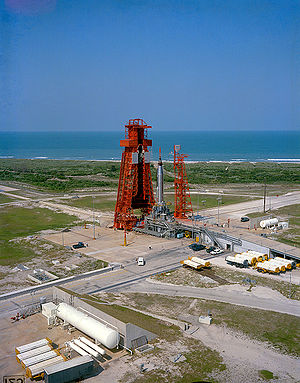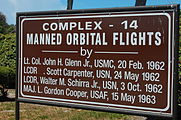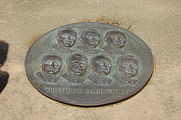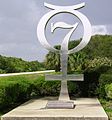- Cape Canaveral Air Force Station Launch Complex 14
-
Launch Complex 14 
Aerial view of Mercury-Atlas 9 at LC-14 in 1963Launch site Cape Canaveral Air Force Station Location 28°29'29"N
80°32'52"WShort name LC-14 Operator US Air Force Total launches 32 Launch pad(s) 1 Minimum / maximum
orbital inclination28° - 57° Launch history Status Inactive First launch Atlas A, 11 June 1957 Last launch Agena Target Vehicle for Gemini 12, 11 November 1966 Associated rockets Atlas
Atlas-AgenaLaunch Complex 14 (LC-14) is a launch site at Cape Canaveral Air Force Station, Florida. LC-14 was used for various manned and unmanned Atlas launches, including the Friendship 7 flight aboard which John Glenn became the first American to orbit the Earth.
Contents
History
LC-14 is most well known as the launch site for NASA's Mercury-Atlas 6 flight, which made Glenn the first American in orbit. It was also the launch site of the remaining three Mercury-Atlas flights and various unmanned Atlas launches. Later, it was the site for Atlas-Agena launches for the Agena Target Vehicles for Project Gemini.
Following decommissioning and abandonment as active launch site, LC-14 slowly fell into decay. The proximity to the Atlantic Ocean created an ideal environment for corrosion of metal components, and the complex's red metal gantry structures were dismantled for safety purposes in the 1970s.
Restoration
In 1997, the 45th Space Wing embarked on a partial restoration of LC-14 under the aegis of the 45th Operations Support Squadron and its commander, Lt. Col Dennis Hilley. Although extensive repairs were made by Boeing and Johnson Controls, with additional assistance from Lockheed Martin and Brown and Root, the restoration utilized no military construction or military operations and maintenance funding was effected strictly with military, DoD civilian, NASA civilian, DoD contractor and NASA contractor volunteers. Several months later, the exterior and interior of the original blockhouse and its nearby astronaut parking area had been restored, with the blockhouse converted into a conference facility for military, NASA and contractor use.
Present at the dedication in May 1998 were former Mercury astronauts Col. Gordon Cooper (USAF Ret.) and Cdr. Scott Carpenter (USN Ret.); Mrs. Betty Grissom, widow of Lt. Col. Gus Grissom (USAF); and comedian Bill Dana, known for his "José Jiménez, the reluctant Astronaut" character. The character caught on among the seven Mercury astronauts. Among other Mercury astronauts, former U.S. Sen. (and Col. USMC Ret.) John Glenn could not attend due to preparations for his then-pending Space Shuttle flight, and Capt. Wally Schirra (USN Ret.) could not attend due to a scheduling conflict. Deke Slayton had died in 1993, while RADM Alan Shepard (USN Ret.) extended his regrets due to illness. Largely unknown at the time was that Shepard was suffering from terminal leukemia, and he died shortly after the dedication.
In addition to the total interior renovation, the blockhouse contains historical documents, photos and memorabilia from Project Mercury, as well as photos of the blockhouse area before, during and after the restoration. Future improvements to the pad itself are also planned as time and contributory funding permits.
The entrance road to LC-14 is marked by several memorials and signs commemorating Project Mercury and the four of six manned Mercury missions launched there. This includes a large sculpture of the Project Mercury symbol constructed of titanium, under which is buried a time capsule containing technical documents of the Mercury program. The time capsule is scheduled to be opened in 2464, 500 years after the official conclusion of the program. With its withdrawal from operational status, a memorial marker in granite was also placed at the beginning of the concrete ramp that leads to LC-14's launch pad; and two outdoor kiosks were erected to contain historical photos.
Gallery
-
LC-14 with Mercury-Atlas 9
See also
- T.J. O'Malley
References
 This article incorporates public domain material from websites or documents of the National Aeronautics and Space Administration.
This article incorporates public domain material from websites or documents of the National Aeronautics and Space Administration.Cape Canaveral and Merritt Island launch sites Atlantic Missile Range drop zone • Grand Turk Island drop zone • Mobile Launch Area • SLBM Launch Area • Patrick AFB • Shuttle Landing Facility • Cape Canaveral AFS Skid StripProject Mercury Missions Unmanned: Little Joe 1 · Big Joe 1 · Little Joe 6 · Little Joe 1A · Little Joe 2 · Little Joe 1B · Beach Abort · Mercury-Atlas 1 · Little Joe 5 · Mercury-Redstone 1 · Mercury-Redstone 1A · Mercury-Redstone 2 · Mercury-Atlas 2 · Little Joe 5A · Mercury-Redstone BD · Mercury-Atlas 3 · Little Joe 5B · Mercury-Atlas 4 · Mercury-Scout 1 · Mercury-Atlas 5
Manned: Mercury-Redstone 3 · Mercury-Redstone 4 · Mercury-Atlas 6 · Mercury-Atlas 7 · Mercury-Atlas 8 · Mercury-Atlas 9Subprograms Rockets Gemini program Missions 
Components Gemini spacecraft · Orbit attitude and maneuvering system · Titan rocket · Agena target vehicle · Gemini space suitLaunch sites Developments Advanced Gemini · Blue Gemini and Manned Orbital Development System · Manned Orbiting Laboratory and Gemini B · Big GeminiCoordinates: 28°29′28″N 80°32′49″W / 28.49117°N 80.546983°W
Categories:- Buildings and structures in Brevard County, Florida
- Cape Canaveral Air Force Station
- Mercury program
Wikimedia Foundation. 2010.







